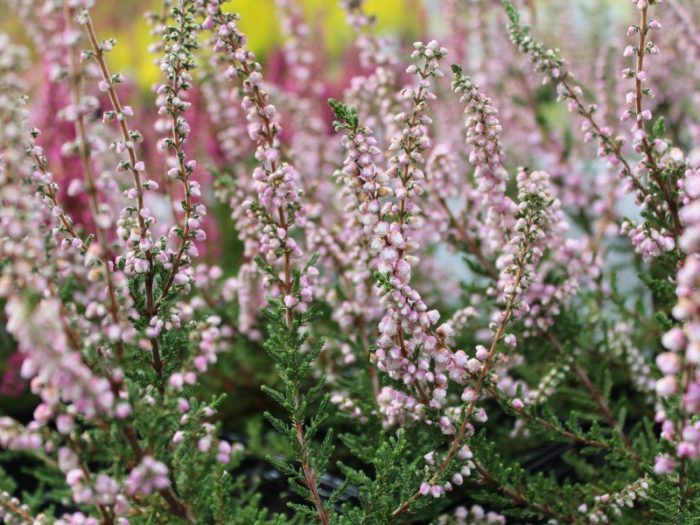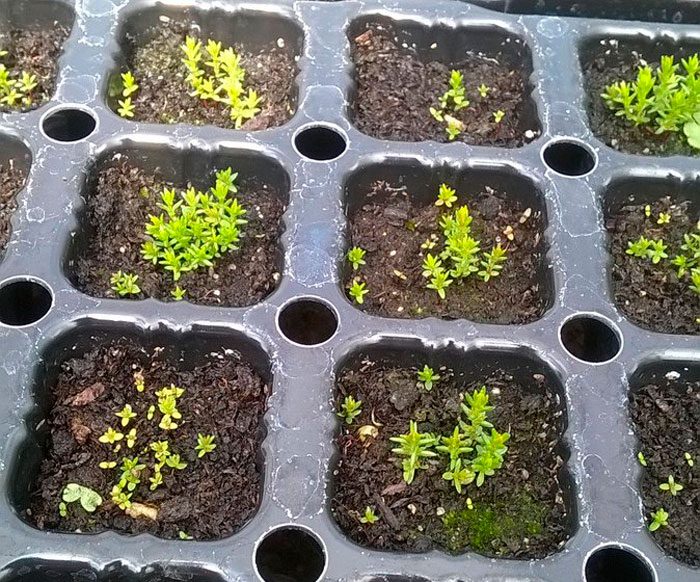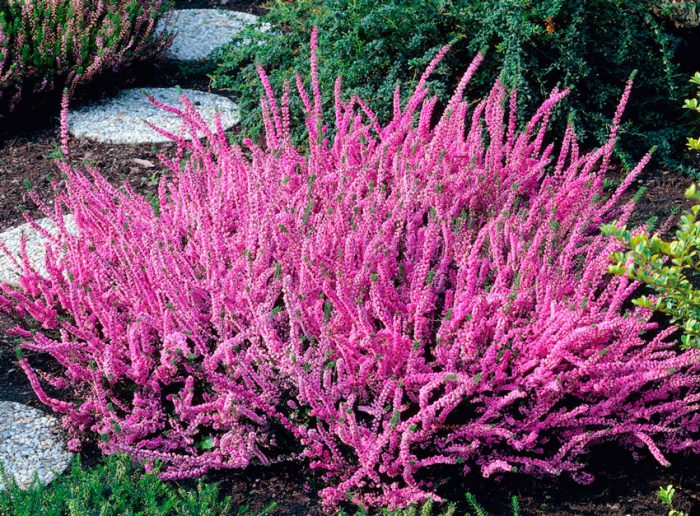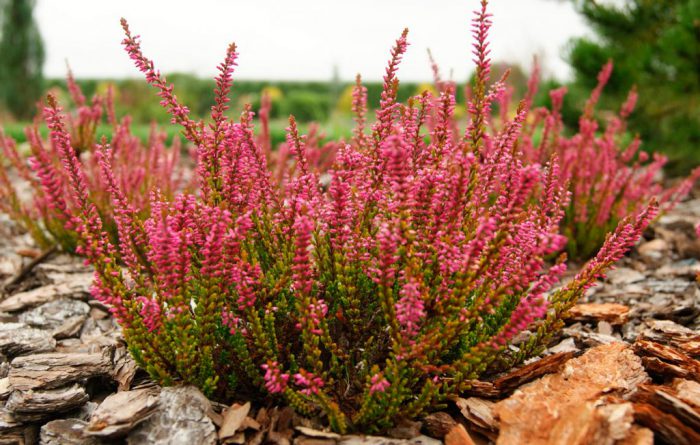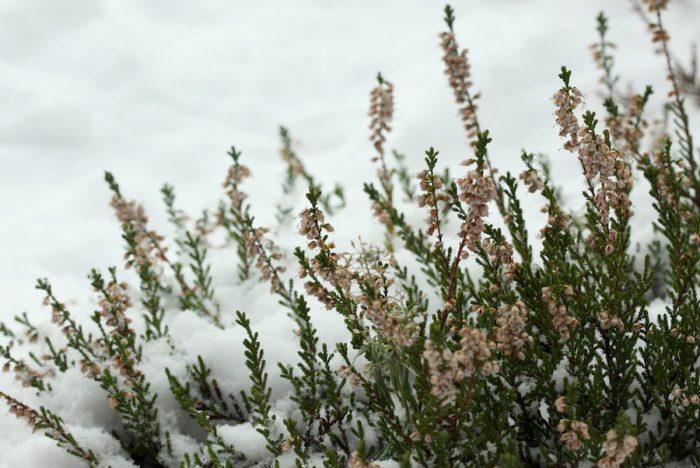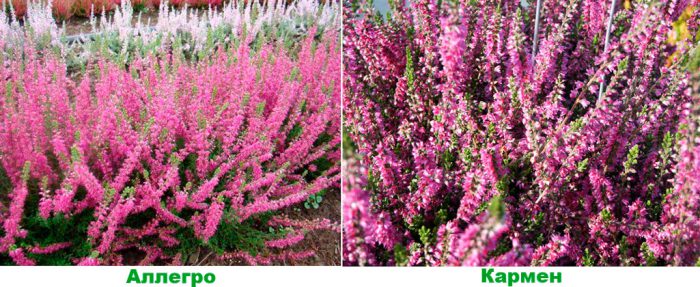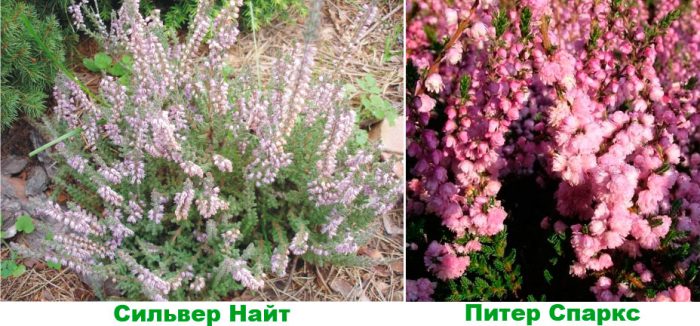The herbaceous evergreen heather (Calluna vulgaris) is the only species of the genus heather belonging to the heather family. Today there are about 500 varieties of this plant, most of which have very high decorative qualities. Under natural conditions, the plant is found in Europe (spreads from the zone of coniferous-broadleaf foxes to the tundra), in North Africa, Greenland, in the temperate latitudes of Asia, in the Azores, on the Atlantic coast of North America, while it prefers to grow in peat bogs, burnt places and forests. An old Scottish legend says that of all plants, only heather agreed, at the request of the Creator, to grow on rocky bare hills, which are blown by all winds, for which he was awarded unpretentiousness, endurance, good aroma and charming appearance. And today, in those places where heather grows, there is no other plant anymore. Sometimes it occupies huge areas, which are called heather wastelands. Veresk gave the name to September in Belarusian, Ukrainian and Polish, namely: Veresin, Verasin, wrzesien.
Content
Features of heather
Heather is a strongly branching evergreen creeping small shrub 30–70 centimeters high. Small leaf plates that are triangular, as if rolled into a tube. Small fragrant flowers that look like bells are painted in lilac-pink color. They are part of the one-sided brushes. Flowering begins in the second half of the summer period, but such a plant becomes the most beautiful after the onset of the first frost, because its leaves at this time turn burgundy and yellow. Robert Louis Stevenson wrote the whole heather ballad, Heather Honey. Such a plant is an excellent honey plant, while heather honey is considered the most useful of all.Landscape designers use heather to decorate alpine hills, plant it along paths in the garden, and use it to create borders that look very impressive against the background of dwarf conifers.
Growing heather from seeds
Sowing seeds
To grow heather from seeds, you need to be patient, because this process is quite long and difficult. However, it may please you that heather seeds have an excellent germination rate, namely, 90 percent. The bowl must be filled with earth mixture and moistened. Spread the seeds over its surface, but you do not need to bury them. Cover the container with glass and wait for seedlings. For sowing seeds, it is recommended to use a substrate consisting of sand, coniferous soil and peat, which are taken in a 1: 1: 2 ratio. Crops need to be put in a warm place (about 20 degrees), while in the first 7 days the seeds need an increased level of moisture. The first shoots appear after 4 weeks. Immediately after the appearance of the seedlings, they should be hardened. To do this, you should open the shelter for a while. After the seedlings grow strongly, a pick should be made, they are planted in individual pots or transplanted into a container.
Seedling care
In the summer, the seedlings should be transferred to the garden and placed in a semi-dark place, while they should be systematically watered. When it becomes cold outside, the seedlings are transferred to a cool room (about 10 -12 degrees).
It is possible to plant heather in a permanent place only at the age of two. Remember that seed grown heather is not capable of retaining the characteristics of the parent plant. However, as a result of your labors, a completely new variety may appear.
Planting heather in open ground
Where and at what time do they disembark
Experienced gardeners recommend planting heather in the spring, namely, from the second half of April to the first days of May, you can do this in the fall - from the end of September to the first days of October. For planting, it is better to choose open, well-lit areas, but you can plant this plant in partial shade. Peaty wet soils or dry sandy soils are best suited for it. It is impossible to plant this flower in lime soil. It's okay if the soil contains few nutrients, but the pH must be 4.5–5.5. Heather will grow best in a soil consisting of sand, peat, bark compost (coniferous soil), which should be taken in a 1: 3: 2 ratio. The area where the heather is grown must be protected from gusts of wind. To acidify the soil, it is necessary to add red high-moor peat to it.
How to plant
Depending on the variety, from 6 to 10 seedlings are planted on a 1 square meter plot. The bush should be buried 25–35 centimeters into the soil, while the root collar should be flush with the soil surface. If the soil is clayey in the planting hole, it is necessary to make a drainage layer consisting of sand or brick fragments, while its height should be from 5 to 10 centimeters. Also, horn flour (30-50 grams) and nitrophoska (20-30 grams) should be added to each hole. The planted heather is watered at the rate of 5-6 liters of water per 1 bush. The surface of the site must be sprinkled with a layer of mulch (coniferous chips or peat). Remember that this plant does not tolerate transplanting very well, so you need to immediately choose the optimal place for planting it and take good care of it so that you do not have to transplant it.
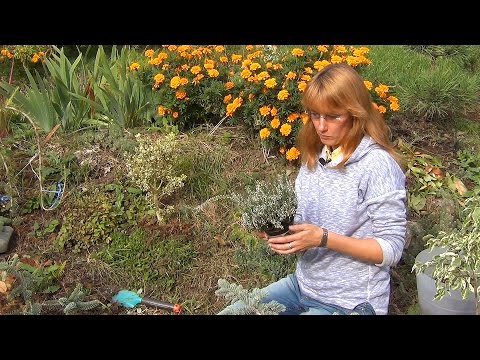

Watch this video on YouTube
Care features
The root system of heather is short, so it needs to be watered regularly if there is no systematic precipitation, while acidified water is used. Please note that the soil surface on the site must be constantly slightly moistened.In this regard, the surface of the soil must be covered with a layer of mulch. Also, mulch does not allow the soil to heat up much on hot days. Water the heather every 10-15 days. After watering is carried out, you need to loosen the soil to a depth of 10 to 15 centimeters, while pulling out all the weeds. It is necessary to loosen and weed the soil through the mulch. In hot times, this plant can suffer from excessively dry air, in this regard, it is recommended to humidify it from a sprayer every evening. Do not forget to feed the plant every year in the spring (in April or May), while full mineral fertilizer is applied to the soil, 1.5–2 large tablespoons of fertilizing are taken per 1 bush (from 20 to 30 grams per 1 square meter). In this case, dry fertilizer must be carefully scattered over the area, try to prevent the substance from getting on the foliage and flowers of the plant, otherwise a burn will form on their surface. After that, the top dressing must be sealed in mulch, and the soil must be watered abundantly. Every year in the spring it is necessary to prune, which performs a formative function, and also stimulates the growth of young shoots. At the same time, intensive pruning can only be carried out when 3 years have passed since the moment the heather was planted. Try to keep the crown shape. Haircut rule: the inflorescence with the left hand must be held by the upper part, and with the right hand - you need to cut off ½ or 2/3 of the inflorescence. The cut pieces can be finely chopped and sprinkled over the top of the mulch.
Pests and diseases
This plant is highly resistant to harmful insects and diseases, but sometimes viral or fungal diseases are affected. Often, heather gets sick with gray rot. The development of this disease may be due to poor water permeability of the soil, either due to the fact that in spring the snow cover melts too quickly, as a result of which the liquid stagnates in the root system. In an infected specimen, plaque appears on the stems, then the leaves and the shoots themselves die off. To combat the disease, plant treatment with fungicidal agents is used, and Topaz and Fundazol cope with this disease best of all. If the bush is very badly affected, then treatment with a solution of copper sulfate (1%) will be required. It is necessary to process heather 3 times at intervals of 5-10 days. For prevention purposes, the plant is treated in spring with fungicides immediately after the shelter is removed from it. It is also necessary to spray the bushes in the fall during preparation for winter.
If the bush is infected with powdery mildew, then young shoots begin to wither, and a whitish loose bloom appears on the leaf plates. If brown-red spots appear on the leaves, this means that the heather is infected with rust. These two diseases are fungal, like gray rot, so they are fought with fungicidal agents.
If the bush is struck by a viral disease, then its flowers or stems may become deformed, and the color of flowers and leaves becomes uneven, it becomes uncharacteristic for this variety. This disease cannot be cured; therefore, the affected plants must be dug up and destroyed. The area on which they grew must be watered with a very strong solution of potassium manganese.
In the event that a plant is grown on soil that suits it and receives the necessary care, then it is unlikely to get sick.
Heather propagation
How to propagate this plant by seeds is described above. Heather can also be propagated by layering, dividing the bush or by cuttings. At the end of the summer period, you need to cut off the apical cuttings, while they are taken from the strongest flowering branches. For rooting, they are planted in pots filled with a mixture of peat and sand (3: 1). They need to be placed in a cool place (from 15 to 18 degrees), while the soil should be constantly slightly damp.Once every 1.5–2 months, cuttings need to be fed, for this they use a urea solution (1 gram of substance per 1 liter of water) or micronutrient fertilizer. In springtime, rooted plants are transplanted into open soil.
Heather often reproduces by layers on its own. Over time, old heather branches will lodge on the surface of the soil and give rise to roots. In order to get a cut, it is necessary to bend the mature stem located at the very bottom and fix it on the surface of the earth. Then it is covered with a layer of peat, the thickness of which should be 10 mm. After 12 months, it will be necessary to separate the layers and plant it in a permanent place.
Heather is most simply and easily propagated by dividing the rhizome. This procedure is carried out at the end of the summer period. To do this, you need to dig a mature bush. It is not necessary to remove the soil from the roots, they are cut into several parts so that each of the divisions has roots and young growth. Before planting the cut, you should cut off the old stems. They are planted immediately in a permanent place in different holes, and do not forget to sprinkle the cuts with crushed coal.
Heather after flowering
In regions with warm climates, this plant perfectly tolerates winter without shelter. But in the event that the winters are harsh and little snow, it is better to prepare the heather for wintering. When frosts come, the surface of the site must be sprinkled with a layer of peat, and then the heather itself should be covered with spruce branches, which will protect the plants from frost and sunburn in spring. It will be necessary to remove the shelter in April.
The main types and varieties with photos and names
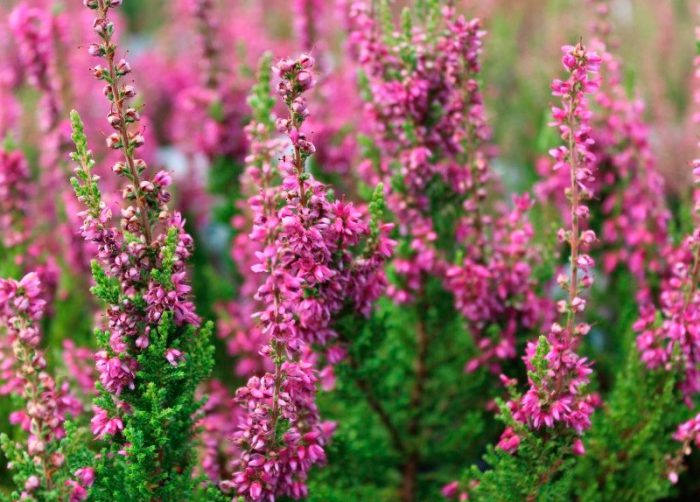

Common heather (Calluna vulgaris) - this is the only species in the genus. Erica is often considered heather, which is closely related to this plant. However, heather and erica are different plants. The common heather has a huge number of excellent varieties, at this time there are about 500 pieces. Gardeners divide all of these varieties into 6 different groups.
1 group. Varieties with green foliage
- Allegro... The height of this evergreen shrub is about 0.6 m, and its crown has a diameter of about 0.5 m. There is a compact, rather dense crown, dark brown bark and scale-like leaf plates of a dark green color. Flowering is observed from the last days of July to the end of October. Red-carmine flowers are simple glossy, they are collected in long inflorescences. The plant is winter-hardy, only young bushes need to be covered for wintering.
- Carmen. This hybrid variety, bred in Holland, is very popular in European countries. The bush reaches 0.3–0.4 m in height, has a rounded crown, small dark green leaves, dark brown bark, simple pinkish-purple flowers that are collected in peduncles (up to 10 centimeters long). Hardy, but needs shelter during winter.
Also popular are such varieties as: Radnor, Duckness, Ross Hutton, Mazurka, Marco, Barnett Anley, Hookstone, etc.
Group 2. Varieties with white flowers and green leaf plates


- Alba... The height of the erect bush is about 0.4 m, while the crown has a diameter of about 0.55 m. On the ascending branches are rich green leaf plates. White flowers are collected in dense racemose inflorescences.
- Alexandra... The spherical bushes reach 0.3 m in height, while the crown diameter is 0.4 m. The leaf plates are dark green in color, and the flowers are pale cream, while by the end of flowering they turn dark red.
Also popular are such varieties as: White Lone, Humpty Dumpty, Long White, Alec Martin, Alba Jay, etc.
Group 3. Varieties with silvery foliage
- Silver Knight... This variety is bred in England. The height of the bush is about 0.3 m, and the diameter of the compact cushion crown is 0.45 m. The bark is dark brown, grayish-silvery leaf plates are pubescent. In winter, the leaves turn burgundy.Simple lavender or lilac flowers are collected in inflorescences having a length of 20 centimeters. It is resistant to cold, but it needs to be covered for the winter.
- Peter Sparks... The variety is also obtained in England. The height of the bush is about 0.5 m, and the diameter of its oval crown is 0.6 m. The bark is dark brown, small scaly leaves are dark green in the summer-autumn period, and greenish-gray in the winter-spring period. Terry dark pink flowers are part of inflorescences, the length of which is 0.3 m. Possesses moderate frost resistance.
Also popular are such varieties as: Annmarie, Velvet Fashion, Ian Decker, Glendwick Silver, etc.
4 group. Varieties with golden foliage
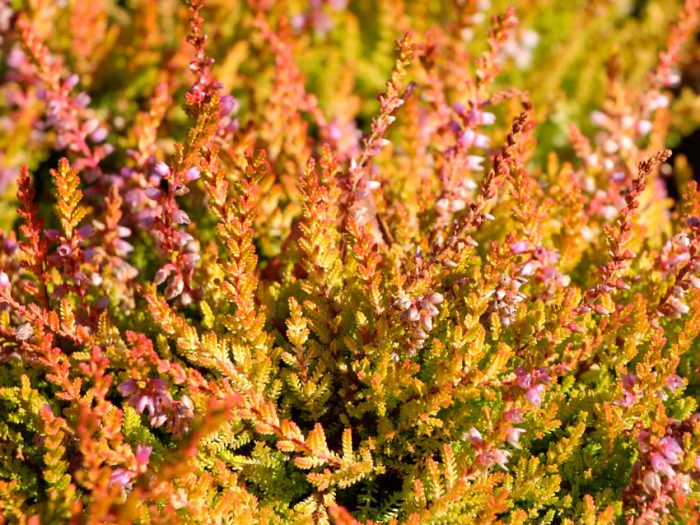

- Andrew Proudley... The bush reaches a height of 15 centimeters, while the diameter of its crown is about 25 centimeters. The broad ascending branches are rather thin. In the warm season, the foliage is orange and has light yellow tips, and in the winter it turns bronze. Small pink flowers are part of loose inflorescences.
- Boskup... The variety was created in Holland. The bush reaches a height of 0.4 m, and the diameter of its compact crown is 0.5 m. The bark is dark brown. In summer, the leaf plates are greenish-yellow, and in autumn they turn reddish-copper. Simple lilac-pink flowers are part of short, low-branched inflorescences, which reach about 10 centimeters in length. Possesses moderate frost resistance.
Other popular varieties are: Aura, Arran Gold, Blazeway, Crimson Sunset, Gold Hayes, Cottswood Gold, etc.
5 group. Varieties with double flowers
- Autumn Glow... The height of the spreading shrub is about 0.3 m, and the diameter of its crown is about 0.45 m. The ends of the branches are raised. Dark green leafy plates, lavender densely double flowers are part of short, rather dense racemose inflorescences.
- Monica... The height of the broadly spreading shrub is 0.55 m, and the diameter of its crown is 0.8 m. The broad ascending branches are very strong. Dark green leaf plates acquire a grayish bloom in winter. Double reddish-pink flowers are very large, collected in dense racemose inflorescences.
Also popular are such varieties as: Red Favorite, Dark Star, Alba Plena, Joan Sparks, County Viclow.
6 group. Varieties with non-expanding flowers
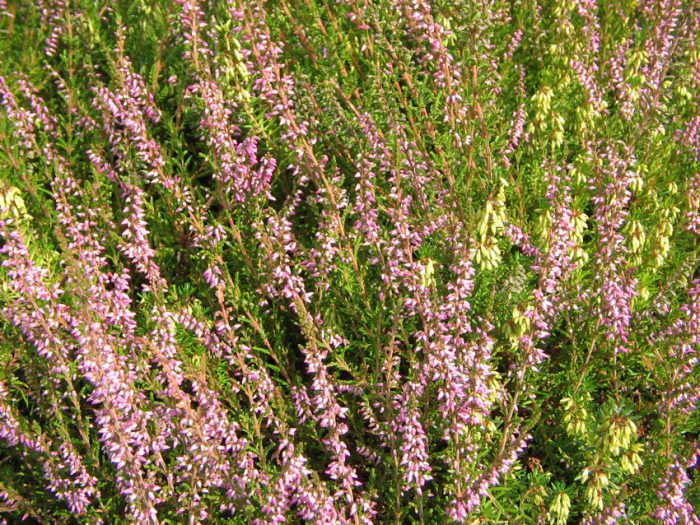

- David Eason... The height of the spherical bush is about 20 centimeters, and the diameter of its crown is 25 centimeters. There are a large number of ascending branches. The leaf plates are dark green. Lilac-pink dark flowers are part of the short brushes.
- Marlin... German variety. The shrub reaches a height of about 0.3 m, and its crown diameter is 0.5 m. Dark brown bark, small dark green leaf plates. The buds of mauve or deep purple never open.
Also popular are such varieties as: Romina, Minima, Fritz Kircher.
The benefits of heather
Heather has medicinal properties that are used in both folk and traditional medicine. It is widely used in the treatment of cough, kidney disease, cystitis, pyelitis, urethritis, dysentery, diarrhea, gastritis, enterocolitis, rheumatism, gout, and skin diseases. Blooming heather is harvested from the last days of June to September, because during this period it contains the largest amount of useful substances: flavonoids, mineral salts of phosphorus, potassium, calcium and sodium, organic acids. Thanks to them, the plant has antibacterial, anti-inflammatory, diaphoretic, wound-healing, expectorant, diuretic, astringent, cleansing and sedative effect.
A decoction of this shrub is used for insomnia and disorders of the nervous system, for vascular atherosclerosis, diseases of the gastrointestinal tract, high acidity, cholecystitis and obesity. If the throat is inflamed or there is inflammation in the mouth, then the broth is used for rinsing.Alcohol tincture on this plant helps with tuberculosis. From the crushed flowers, a powder is made that helps with ulcers, eczema, wounds and burns. With radiculitis, take heather baths. The infusion made from flowers is rubbed into the scalp, this helps to get rid of hair loss and improve their health.
Everyone can take heather, but nevertheless, before starting treatment with this plant, you should consult with an experienced doctor. It is better to refrain from ingesting medications made from heather, for those who have low gastric acidity.


Watch this video on YouTube

